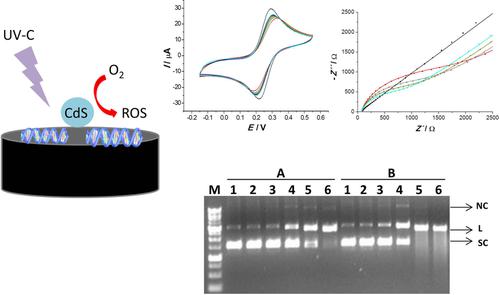当前位置:
X-MOL 学术
›
Electroanalysis
›
论文详情
Our official English website, www.x-mol.net, welcomes your feedback! (Note: you will need to create a separate account there.)
Detection of ROS Generated by UV‐C Irradiation of CdS Quantum Dots and their Effect on Damage to Chromosomal and Plasmid DNA
Electroanalysis ( IF 3 ) Pub Date : 2017-12-21 , DOI: 10.1002/elan.201700648 Jana Blaškovičová 1 , Jozef Sochr 1 , Anastasios Koutsogiannis 2 , Dimitra Diamantidou 2 , Pavel Kopel 3, 4 , Vojtech Adam 3, 4 , Ján Labuda 1
Electroanalysis ( IF 3 ) Pub Date : 2017-12-21 , DOI: 10.1002/elan.201700648 Jana Blaškovičová 1 , Jozef Sochr 1 , Anastasios Koutsogiannis 2 , Dimitra Diamantidou 2 , Pavel Kopel 3, 4 , Vojtech Adam 3, 4 , Ján Labuda 1
Affiliation

|
Different sensitivity of various types of DNA to damage and mutation requires a study of effects of chemical and physical factors on integrity of individual DNA structures. Oxidation stress induced by photoactivated nanoparticles including quantum dots is considered to be the main mechanism of their potential risks. In this work, spectrophotometric indicators of reactive oxygen species (ROS) 4‐chloro‐7‐nitrobenzo‐2‐oxa‐1,3‐diazole (NBD−Cl) and α‐diphenyl‐β‐picrylhydrazyl (DPPH), electrochemical DNA‐based biosensors with the thiol‐capped CdS quantum dots (CdS QDs) immobilized over the chromosomal (ct DNA) and plasmid (pUC19) DNA biorecognition layers and agarose gel electrophoresis were used (i) to detect ROS generated at the UV‐C irradiation (λ=254 nm) of CdS QDs and (ii) to assess and evaluate their effect towards the chromosomal and plasmid dsDNA structure. Voltammetric and impedimetric measurements revealed a deep degradation of DNA attached to the glassy carbon electrode surface with a stepwise decrease of the portion of survived pUC19 and ct DNA after 60 s to 2400 s irradiation time up to 47 % and to 32 %, resp., comparing to the portion in the absence of CdS QDs reaching 58 % and 40 %, resp. Agarose gel electrophoresis supported the damage to plasmid and chromosomal DNA demonstrating double strand breaks. A decrease in the stability of DNA types towards degradation by ROS in order pUC19>calf thymus>salmon sperm dsDNA has been found.
中文翻译:

检测CdS量子点的UV-C辐射产生的ROS及其对染色体和质粒DNA的损伤
各种类型的DNA对破坏和突变的不同敏感性要求研究化学和物理因素对单个DNA结构完整性的影响。由包含量子点的光活化纳米颗粒引起的氧化应力被认为是其潜在风险的主要机制。在这项工作中,活性氧(ROS)的分光光度指示剂4-氯-7-硝基苯并-2-氧杂-1,3-二唑(NBD-Cl)和α-二苯基-β-吡啶并肼(DPPH),基于电化学DNA的生物传感器具有固定在染色体(ct DNA)和质粒(pUC19)DNA上的巯基封端的CdS量子点(CdS QDs)DNA生物识别层和琼脂糖凝胶电泳(i)用于检测UV-产生的ROS CdS QD的C辐射(λ= 254 nm)和(ii)评估和评估它们对染色体和质粒dsDNA结构的影响。伏安法和阻抗法测量显示,附着在玻璃碳电极表面的DNA发生了严重降解,在60 s至2400 s的辐照时间后,存活的pUC19和ct DNA的比例逐步降低,分别达到47%和32%。与没有CdS QD的部分相比,分别达到58%和40%。琼脂糖凝胶电泳证实了质粒和染色体DNA的损坏,表明双链断裂。
更新日期:2017-12-21
中文翻译:

检测CdS量子点的UV-C辐射产生的ROS及其对染色体和质粒DNA的损伤
各种类型的DNA对破坏和突变的不同敏感性要求研究化学和物理因素对单个DNA结构完整性的影响。由包含量子点的光活化纳米颗粒引起的氧化应力被认为是其潜在风险的主要机制。在这项工作中,活性氧(ROS)的分光光度指示剂4-氯-7-硝基苯并-2-氧杂-1,3-二唑(NBD-Cl)和α-二苯基-β-吡啶并肼(DPPH),基于电化学DNA的生物传感器具有固定在染色体(ct DNA)和质粒(pUC19)DNA上的巯基封端的CdS量子点(CdS QDs)DNA生物识别层和琼脂糖凝胶电泳(i)用于检测UV-产生的ROS CdS QD的C辐射(λ= 254 nm)和(ii)评估和评估它们对染色体和质粒dsDNA结构的影响。伏安法和阻抗法测量显示,附着在玻璃碳电极表面的DNA发生了严重降解,在60 s至2400 s的辐照时间后,存活的pUC19和ct DNA的比例逐步降低,分别达到47%和32%。与没有CdS QD的部分相比,分别达到58%和40%。琼脂糖凝胶电泳证实了质粒和染色体DNA的损坏,表明双链断裂。



























 京公网安备 11010802027423号
京公网安备 11010802027423号